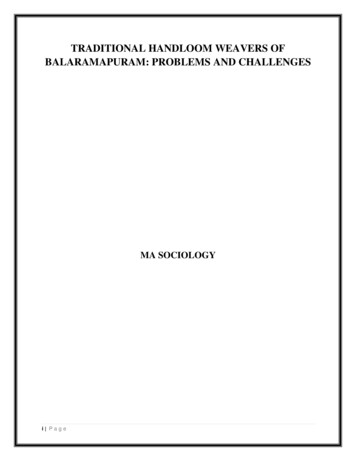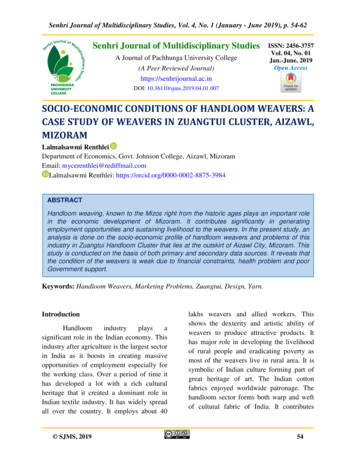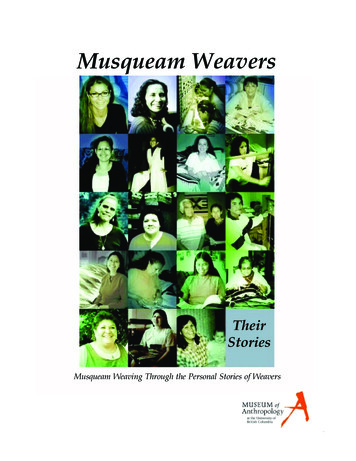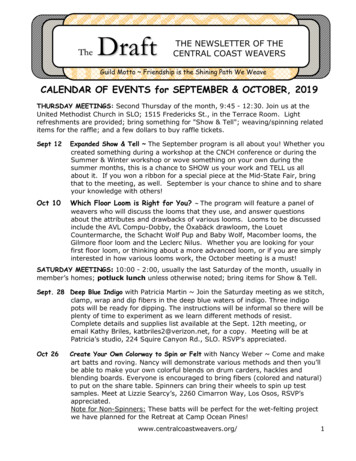
Transcription
TRADITIONAL HANDLOOM WEAVERS OFBALARAMAPURAM: PROBLEMS AND CHALLENGESMA SOCIOLOGYi P a g e
TABLE OF CONTENTSLIST OF 1-12IILITERATURE REVIEW13-29IIIMETHODOLOGY30-32IVANALYSIS AND INTERPRETATION33-44VFINDINGS, CONCLUSION 0INTERVIEW SCHEDULEii P a g e
LIST OF TABLESFIGURENO:TITLE OF THE TABLEPAGENUMBER4.1Age group of the respondents344.2Gender344.3Education of the Weavers354.4Source of Income of Weavers354.5Level of income of Weavers364.6Lives in364.7Accessibility of bonus374.8Wages374.9Parallel job374.10Health problems384.11Bases of income384.12Number of weavers who weave designer saree394.13Difficulties394.14Availability of extra wages394.15Awareness of marketing trends404.16Problems due to lack of technological upgradation404.17Courses414.18Techniques to improve the demand41iii P a g e
4.19Measures taken by the government424.20Demand of product424.21Government initiative for install machines434.22Measurement of profit434.23Is the powerloom require any skill444.24Why still follow the traditional mode of weaving44iv P a g e
ABSTRACTThe present study is titled as Traditional handloom weavers of Balaramapuram: Problems andChallenges. The study focuses on the various socio economic challenges faced by the traditionalhandloom weavers of kottukalkkonam handloom industry at Balaramapuram panchayat. Thestudy was quantitative in nature and collected data using interview schedule.Handloom sector is a major traditional industry. But now it is in the edge of its extinction mainlydue to the invasion of power loom. The problem faced by the handloom industry affect the life ofweavers. As a part of it the traditional Weavers also faces problems and challenges. They facedvarious socio-economic and physical problems and challenges. The Weavers get wages andbonus on time but it is not sufficient to maintain the economic balance. So they seek other jobsparallel to it. Majority of the members are women in this study who are engaged in weaving.And the male members in the family do not only involve in weaving they also goes to other jobswhich have more income. So, this study reveals that majority of the family are not onlydepending on the handloom. But a small proportion of people still completely depending onhandloom.The handloom industry is now on the edge of its decline. But in market the handloom productstill have highest demand. Due to the lack of sufficient income the Weavers and the youngstersare hesitant to join this industry thus so many handloom units were closed so, there is nosufficient production processing even if the demand is high.Another challenge faced by this industry is that the invasion of power loom products in the nameof balaramapuram kaithari. In this case the customers are not able to identify the real handloomproduct. The sellers also encourage to the power loom product. So it is the main problemaffecting the Industry.The handloom product has high quality than the power loom. It is what the factor which attractthe people to the handloom product. But the customers do not have the ability to identify what ishandloom and what is power loom. It only can be identified by the weavers . It is the majorchallenge what the industry faces in modern times.From the present study it is concluded that Handloom weavers in Balaramapuram are mostlytraditional weavers and they are in a pitiable condition, owing to poor socio-economic condition.However various unfavourable factors lead to decline on the aspect of socio-economic conditions.Majority of them are wage weavers working for more than 8 hours.v P a g e
CHAPTER IINTRODUCTIONIndian Handloom Industry is an ancient cottage industry of India with a decentralized set up.This industry is a source of livelihood for millions of people and contributes a major part towardsemployment. The tradition of making handicrafts and weaving by hand constitutes one of therichest and vibrant aspects of the Indian cultural heritage. This sector is one of the largestunorganized sector after agriculture having being an advantages of less capital intensive,minimal use of power, eco-friendly, adaptability to market requirements etc. But at the sametime, this industry is facing multifarious problems that some other industries did not face. Thegovernment of India also acting toward the development and improvement of its productivityand marketing, still weavers are facing livelihood crisis. So that it is the need of the today toidentify the problems as well as the strengths and weaknesses of handloom industry to make itprofitable (Jain, 2017)What is Handloom?Handloom refers to wooden frames of different types which are used by skilled artisans to weavefabrics usually from natural fibers like Cotton, Silk, Wool, Jute etc. It is a cottage industrywhere the entire family is involved in the production of cloth. Right from spinning the yarn,coloring, to weaving on the loom is done by them. Fabric produced from these looms is alsoreferred to as Handloom.Tools required for this entire process are made from wood, sometimes bamboo and they do notrequire any electricity to run them. The entire process of fabric production was totally manual inearlier times. Thus this is the most eco-friendly way of producing clothes (Kohli 2019).History of Handloom – Early DaysIndian Handloom dates back to the Indus valley civilization. Even in ancient times, Indianfabrics were exported to Rome, Egypt and China.In earlier times, almost every village had its own weavers who made all the clothingrequirements needed by the villagers like sarees, dhotis, etc. Some areas where it is cold in1 Pag e
winter there were specific wool weaving centers. But everything was Hand-Spun and HandWoven.Traditionally, the entire process of cloth making was self-reliant. The cotton / silk / wool camefrom the farmers, foresters or shepherds, and the cotton was cleaned and transformed by weaversthemselves or agricultural labour community. Small handy instruments were used in the process,including the famous spinning wheel (also known as Charkha), mostly by women. This m/.Decline of HandloomDuring British rule, India was turned into an exporter of raw cotton and the country was floodedwith machine made imported yarn. To increase consumption of this yarn, British authoritiesresorted to violence and coercion. Summarily, this resulted in a complete loss of livelihoods firstfor the spinners, and dependence of handloom weavers on machine yarn.When yarn came from a distance and had to be bought, yarn dealers and financiers becamenecessary. And as the average weaver had little credit, the industry fell more and more into thegrip of middlemen. Thus the independence of most weavers disappeared, and a great majority ofthem came to work for a trader on contract/ wage basis.Despite this Indian handloom sustained itself, until World War 1 when imported machine madeclothes flooded the Indian Market. The beginning of Power looms in the 1920’s, and theconsolidation of the mills and the high cost of yarn, made an unfair competition that led to thedecline of Handloom.Revival of HandloomMahatama Gandhi started the Swadeshi Movement and reintroduced hand spinning in the nameof Khadi which essentially means hand spun and hand woven. Every Indian was urged to spinthe yarn using Charkhas and wear Khadi. This led to the closure of the Mills in Manchester andhuge turning point in the Indian independence movement. People burnt imported clothes andchose to wear Khadi.2 Pag e
Handloom – Post IndependencePost Independence, textile mills and spinning mills continued to function in India. Today, thereare many weaving styles that use machine spun yarn and these fabrics are referred to asHandloom. And fabrics made from Handspun yarn are called Khadi fabrics.Though the textile and spinning mills continued in Independent India, handloom / khadi weregiven a lot of protection from unfair competition. Thus the fabric was widely used and affordablefor everyone.Current ScenarioSince 1985, and especially post 90’s liberalisation, handloom sector had to face competitionfrom cheap imports, and design imitations from power looms.In addition government funding and policy protection also declined drastically. Also the cost ofnatural fiber yarn has increased tremendously. In comparison to artificial fiber, the cost of naturalfabric has gone up. This makes it unaffordable for the common people. But the wages ofhandloom weavers have remained frozen for the past decade or two.Unable to compete with cheaper poly-mixed fabrics, many weavers are quitting weaving andgoing for unskilled labour work. And many have been reduced to extreme poverty.Traditional wear in India has lost its significance slowly with the advent of low cost and eyecatchy synthetic materials. However, with the notion of ‘Make in India’ campaign and theplanning commission giving it a due place in the economic sector under other priority sectors isregaining its unique identity. USA, UK, Germany and France are among the top ten countries towhere the Indian handloom products exported. The Indian government launched Handloombrand to ensure its uniqueness, flexibility of production, openness to innovations, adaptability.The number of handloom weaver households decreased in the third handloom census comparedto that of second. So as to support weavers the Indian government launched schemes andinitiated exhibitions, crafts museum, trade facilitation centre and E-commerce. Market researchon the Handlooms identified the need for publicity, availability, Handloom designer dresses andawareness campaigns on a large scale for its sustenance.3 Pag e
The handloom sector has a unique place in our economy. It has been sustained by transferringskills from one generation to another. The strength of the sector lies in its uniqueness, flexibilityof production, openness to innovations, adaptability to the supplier‘s requirement and the wealthof its tradition (Upahar 2018).The Government of India, since independence, has been following a policy of promoting andencouraging the handloom sector through a number of programmes and schemes. Due to variouspolicy initiatives and scheme interventions like cluster approach, aggressive marketing initiativeand social welfare measures, the handloom sector has shown positive growth and the incomelevel of weavers has improved. The handloom fabric production has been very impressive andgrowth has been at the rate of 6% to 7% in the beginning of the 11th Plan. The subsequenteconomic downturn has affected all the sectors in India and handloom sector was noexception. Indian handlooms are characterized by an infinite variety of weaves, textures anddesigns spun on the handloom, ranging from the finest muslins to heavy bedspreads, fromdelicate pastels to earthy hues, and from appealingly simple to amazingly every need, fromexquisite fabrics, which take months to weave, to popular items of mass production for daily use.Handloom, being a State subject, its development is primarily the responsibility of the StateGovernments. However, the Government of India has been supplementing the efforts of theStates with its policy of promoting and encouraging the sector through suitable interventions.HANDLOOM IN KERALAKerala's handloom products are well known for their intricate designs, exquisite craftsmanship,vibrant colours and delicate texture. For centuries, a majority of the product has been madefamilies of weavers, each with a unique story on how they were introduced to this special trade.Each such centre of weaving has its own signature characteristics and the state has three majorweaving centres.Kuthampully in Thrissur, famous for its kasavu double dhoti, veshti and set mundu.Balaramapuram in Thiruvananthapuram traces its past to about 300 years ago, weavers fromTamil Nadu settled here to produce fabrics for the members of the royal family of Travancoreand the dexterity of the Chendamangalam in Ernakulam weavers is renowned across the world.4 Pag e
Each of these places, along with Kasaragod and Kannur saris, form the vanguard of thehandloom revolution in Kerala.Kerala handloom industry carries a vital role in states economy as well as in the field ofemployment. A very large number of looms are located in rural areas. The rhythm of handloomcan be heard in almost every village in Kerala. There are men and women weavers for whomweaving is a way of life. In early days majority of handloom weavers followed the hereditaryline. The main communities engaged in weaving are saliyas and devangas. With the availableinformation it is clear that the saliyas and devangas migrated from the nearby princely states.Earlier they were producing cloth for their own consumption and for the need of their village.Increase in production and improvement in transport facilities removed the hindrance of time andeased the exchange of commodities. The skill of weaving has been passed from parents tochildren (Vargheese &Salim 2015).During 15th century British, French and Portuguese people visited kerala. They were attracted bythe things like spices, ivory and beauty of handloom fabrics. They began to purchase largequantities and exported to their countries.Earlier they were producing cloth for their own consumption and for the need of their village.Increase in production and improvement in transport facilities removed the hindrance of time andeased the exchange of commodities. The skill of weaving has been passed from parents tochildren.During 15th century British, French and Portuguese people visited Kerala. They were attractedby the things like spices, ivory and beauty of handloom fabrics. They began to purchase largequantities and exported to their countries. Germany has established a mission called 'Basalmission' in 1829.This mission paved the way of changing from home production to factorysystem. Apart from this, French people started to give training in weaving. They importedversatile loom and introduced principle designs from the hooks.After the British captured India they took up and nourished handloom industries for theirpurposes. At the end of the 18th century the monopoly came to an end. Since 19 th century withthe advent of industrial revolution, the English people gave up all. They started mechanical5 Pag e
production in their land. During this period of foreigners the weavers of Kerala learned alltechniques and they paralleled the way for the production of furnishing fabrics according to newstyle of demand.During the dawn of 20th century, the Sree Narayana movement influenced kerala society by andlarge prompting the caste based culture to change towards secular and modern industriousculture so that many people from traditional Thiyya/Ezhava community had taken up theiremployment in Handloom Industry to do away with the toddy tapping to respond with the adviceof Sree Narayana Guru. This change also has its own mark in making the present shape of KeralaHandloom Industry. It has resulted in the production of various types of artistic handloom goodsin Kerala.Balaramapuram, in Thiruvanathapuram district is the most historically important place forhandloom fabrics. The weavers belong to Saliyas were migrated from Nagar coil andThirunalveli in Thamil Nadu during the time of Balarama Varma before 250 years. Here theyproduced super fine 'Mundum Neriyathu; for the need of royal family. Still they are in existenceand carry important part of the total production. The technique of producing the superfine fabricspread from them to the local weavers in Balaramapuram and the surrounding places. Initiallythey were producing 'Mundu' for men with 0.4cm of width of 'kara' (cross border) with blackgarn. Before 100 years the jeri from Surat takes to Balaramapuram and 'Kasavu Sarees'production was started.Koothampalli in Thrissur district is also well known for handloom fabric. Here Devangasimmigrated from Karnataka are engaged in weaving. The 'Kasavu Sarees' which are beingproduced here is mostly with half fine jeri. The middle class people would like to purchase thissarees because of its cheapness. The price of a saree can be reduced from Rs.5000 to 1000 byusing half fine jeri instead of pure jeri.Chendamangalam, in the Ernakulam district is also an important handloom centre in Kerala.Here they have been producing the double dhoti and 'Mundu' and 'Neriyathu'.The distinction ofthese fabrics is in its structure in the plain structure, they have producing a special effect in weftdirection.6 Pag e
AREA WISE ANALYSIS OF HANDLOOM IN KERALAKerala has 14 districts from Thiruvanathapuram to Kasargod. The handloom industry is spreadedallover the state. But the handloom industry is concentrated in certain places. The southernKerala is famous for its superfine products, like sarees, dhothies and 'Set mundu' etc. The middleKerala also engaged with such products .But while going to northern side called Malabar themain production changed to coarser varieties like furnishing items bed spreads, towels etc. Thecommon products in Kerala are 'Thorthu' (Bathing towel) and Lungies. Almost 2 lakhs ofweavers are earning their livelihood from the handloom 75% of them are in the co-operative line.Almost 5 lakhs families are depending upon handloom industry.A district wise analysis gives us a clear cut idea about the places where handlooms areconcentrated and the places which are important for traditional varieties.1. ThiruvananthapuramThe capital city has its own historical importance. And in the map of handloom also it has animportant place. There are 349 societies and 44700 weavers are working with their looms. Themain products of district are fine cotton textures, durries with special design Balaramapuram isvery famous for its fine grey sarees with kasavu (Jari). The other products here are set-mundu'Mundum Nereyathum'-(Traditional dress for a malayalu lady), Mundhu (dhothi for men),Earezha thorthu (bathing towel), Melmundu etc. Other places where handloom concentrationsare Parassala the south most of kerala where the weavers are involved in weaving of sareesdhotis Cherayinkeezhu, Kulathur are the other place where handloom density places. Here alsothe productions are as explained above. The range of counts is 60s-120s.The jari used here issuperfine one.2. KollamThe very old city has a few handloom production places. Here almost 80 co-operative societieswith 10271 registered weavers with their looms. In this district almost all varieties produced inKerala are produced in a small scale. In olden days the Kollam (Quilon) was an important port inSouth India. So the effect of exporting items are effected the weavers in kollam district Lungies,furnishing items, earezhathorthu, sarees, dhothies are the main products. Terry towels, Jacquard7 Pag e
durries are also produced. Kollam, Karunagappally, Chathannur are the main places related tohandloom in the district. The products from this place are mainly for domestic market. Thereforecolours, fashions etc. of these products suit the domestic market.3. PathanamthittaThere are 7 co-op societies and 165 registered looms are here. With these 281 weavers areearning their livelihood. In this district the main products are lungies and dhothies.4. Alappuzha (Alappey)Alappuzha is very famous for its coir products. Coir weaving also done with hands only. But it isconsidered as another wing.The main products in these centres are mainly dhotis, sarees, lungies, earezhathorthu etc. Thereare 25 co-op societies with looms and 2309 weavers in this district.5. KottayamIn kottayam district the main products are earezhathorthu, panimundu and lungies. They are alsoproducing bed sheets and sarees. There are 16 societies with loom and 1853 weavers are here.Kidangoor, Karingannoor are major centres6. IdukkiIn this district there are 11 societies and 414 weavers with their looms. The main products aresarees, lungies etc.7. Ernakulam'Chennamangalam saree' is famous in kerala. This fine grey sarees are the product of Ernakulamdistrict. The other main products are superfine double dhothies, synthetic and silk sarees,matching set etc. In Paravoor 120 s fine double dhothies are produced. Paravoor is situated incoastal Ernakulam only the above statal paravoor is situated.In east Ernakulam ,earzha thorthu and cheaper variety bed sheets are produced. There are 30societies and 8494 weavers with their looms.8 Pag e
8. ThrissurThe cultural capital of kerala has an important role in the tradition of kerala. Here a traditionalvariety named 'Koothampally saree' is produced. koothampally is a place situated in Thrissur.The other productions are set mundu, woven with half fine jari. Dhothies, lungies are alsoproduced in this district .There are 30 societies in Thrissur and 6052 weavers.9. PalakkadIn this district its handloom weaving is very popular Chittur, Pudunagaram, Kollengode,Peruvemba,Karimpuzha are some of the handloom concentrated place situated in thedistrict.Here the main products are sarees, dhotis, lungies etc. Here silk sarees production alsostarted recently. There are 45 societies and 11236 weavers depending on the handloom weaveswith their looms.10. MalapuramA number of Muslim weavers are here in this district. The main places are Tiroor, Tanoor etc.The main products are furnishing items which influenced from calicut and saree lungies. Thereare 13 societies and 2774 weavers.11. Calicut or KozhikodeThe districts from Malapuram to Kazargod are known as Malabar. The famous "Malabar loom"came from this place only. The other famous of this place is ,in olden days famous "Calico cloth"came from calicut only.In olden days foreigners established some companies. Some of them remaining now also.'Common Wealth Trust' which is situated in Calicut is one such company.The main products aremainly meant for export. Furnishing , Jacquard products, Bedsheets, Table mats, Coarservarieties etc. The products are mainly coming from Malabar loom.The products from Kozhikodehave an excellent value in domestic market also. The main centres are kozhikode, Quilandi,Vatakara, Chombal, Maniyur etc.There are 41 societies (Most of them are industrial societies)are here.9 Pag e
12. WyanadThere is not that much important in this high range. There are only 4 societies in this district and136 weavers. The products will be a part of Calicut and Cannanore.13. Cannanore or KannurCannanore is called as 'the Manchester of Kerala'. The famous Cannanore sports shirting,varieties like Crepe is the donation of this district. The weavers are mainly working in industrialsocieties. For export of handloom products Kerala mainly depending upon the products fromCannanore. The main products are shirting, Made-ups, jackquard, Furnishing,Turkish towels,Sateen sheets Crepe such export oriented, and Lungies Earezha thorthu etc. for domestic purpose.The products are coarser varieties Cannanore Mundu is a popular variety. The main centres areCannanore, Azhicode, Chirakkal, Kanhirode, Panoor, Kuthuparambu, Kalyassery. There are 73societies established in this district and with about 50 exporters in private sector togetherhave,13667 weavers working open that.14. KasargodKasargod is the north most district in Kerala. Here sarees are produced, and export varieties alsoproduced here Kasargod, Mancheswaram are main centres.11 societies are here nad 3401weavers working in these societies. Kasargod sarees are very famous in Kerala. Now-a-daysthere is a very good demand for the silk sarees woven with different colour pattern dloom plays a vital role in the Indian economy. This industry helps in the creation of ampleopportunities of employment especially for the labour class. It helps in earning considerable sumof foreign exchange to the country thus strengthening the national economy. The handloomindustry has developed a lot over a period of time. It is spread throughout the country. Most ofthe handloom units are run either as sole-proprietors or else they work under master weavers(Bansal,Gaur, 2008). In respect of Kerala in particular, handloom industry carried a vital role inthe state’s economy because of its vast employment generation potential. A very large number oflooms were located even in rural parts of Kerala. The rhythm of handloom used to be heard in10 P a g e
every village. There were both men and women weavers for whom weaving were a way of life.In early days majority of handloom weavers followed the hereditary line. The main communitiesengaged in weaving were Saliyas and Devangas. Today, in spite of its vast potential and hencegrowth prospects, many problems and challenges haunt this sector thus seriously affecting itssustainability, particularly in the Kerala context. The looms disappear one after the other, andthere is constant decline in the number of handloom workers. This sector is now dominated le of Handloom Industry in India.pdf)HISTORY OF BALARAMAPURAM KAITHARIHandloom was introduced by the Maharaja Balarama Varama during his regime. The Maharajaand his Delava (Chief Minister), Ummini Thampi jointly decided to convert Balaramapuram andits surrounding places into an agro-based industrial belt with various traditional industries by thedevelopment of paddy and coconut cultivation, fishing, weaving, and oil extraction. Separatestreets with a clustered at identified places, providing a comparatively better infrastructure fordevelopment.The Delava of Maharaja brought seven weaver families (Shaliars) from Tamil Nadu to producefabrics for the members of the royal family and made them settle at Balaramapuram in a separatelocation now called "Shaliar Street". Market places were opened at convenient locations to makethe marketing of products easier. The present residents of the street are the descendants of theseseven families. Now they are almost 750 families. The place Balaramapuram itself was namedafter the King who started industries in this region.Presently, a major portion of the hand loom clothes produced in this area is sold to the HandloomDevelopment Corporation and Hantex. Due to the emergence of power looms in the weavingindustry and drop in the prices of related items, the inhabitants of the colony have found itdifficult to persevere in the same field of activity as a result of which, the younger )11 P a g eemploymenttomakeends
STATEMENT OF THE PROBLEMThe handloom industry is one of the oldest and the largest cottage industry in India, representingand preserving the vibrant Indian culture. The handloom industry is presently regarded as thelargest economic activity in India after agriculture, generating direct as well as indirectemployment for more than 3 million weavers household. Furthermore, the government hasintroduced the various schemes for holistic development of the sector.However the rapidly increasing industrialization, globalization and advent of modern technologyhas brought with various challenges for the development of the handloom industry especially tothe traditional weavers. The present study is an attempt to understand the problems andchallenges faced by the traditional handloom weavers in the modernized textile industry. It alsotries to shed light into the prospects if any they have in the present scenario.SIGNIFICANCE OF THE STUDYHandloom sector is a major nonfarm industry in India. This sector gives major contribution toIndian economy. Any people who have an interest in weaving can enter into this field as weaversneed not have any high qualification to enter in this job. Handloom sector provides employmentopportunity to 65 lacs persons engaged in weaving and allied activities (dyeing, twisting,construction of work shed and acquisition of looms and accessories). So handloom is consideredas a largest economic activity in textile sector. Government intervention of this sector is endless.A lot of welfare measures and schemes are introduced by government. If the significance of thehandloom sector is such a discussing thing, then the question is why this industry is facing a lotof problems? This study aims to reveal the problems and challenges faced by the traditionalhandloom weavers in the modernised sector and thus significant. The study is relevant in thepresent context of our society as it may contribute to a new understanding from the point of viewof handloom weavers. It may help in making effective policies and programs addressing the realneed of hand loom weavers.12 P a g e
CHAPTER 2LITERATURE REVIEWVenkataraman (1936) discussed the production and marketing structure of handloom industry insouth India. He explained the nature of the relations between production and marketing. Thestudy opined that the systems of production determine the method of distribution. The productionwas more organized in handloom factories. Marketing was done through agencies likecommission agents, mail order houses and so on.Nanekar (1968) analyzed that by increasing the production of handloom industry substantiallynothing tangible can be gained by solving other problems. The long term and importantcomponents in earning depends on the productivity of labour a problem ultimately associatedwith the technique of production.Aurlanadam, (1979) analyzed 'A Study of Handloom Industiy in Tamil Nadu', highlighted theproblems of weavers' co-operatives in major weaving centers as shortage of quality inputs,technological stagnation and inadequate marketing techniques.Jain (1985) mentioned that protection of handlooms against unequal competition from mills a
From the present study it is concluded that Handloom weavers in Balaramapuram are mostly traditional weavers and they are in a pitiable condition, owing to poor socio-economic condition. However various unfavourable factors lead to decline on the aspect of socio-economic conditions. Majority of them are wage weavers working for more than 8 hours.










